

The 6420
Letters to the Editor
Letter from the Editor

Welcome to our final 2018 issue of The 6420 and my final issue as Editor-in-Chief.
I have been fortunate to have been a part of a great staff, both current and past. Attending Rose State College has been one of the best career decisions I made. The student publication has been the most academically enriching experiences I have had. Thank you to all my staff and everyone who makes this publication possible. Most of all thank you to all of our loyal readers.
I would like to give a special thanks to Professor Darcy DelaneyNelson. I have learned skills beyond my expectations through her and I have grown as a person through her guidance and support.
Congratulations to our future Editor-in-Chief, Yesenia Gonzalez. I hope everyone enjoys our Winter 6420 edition. Thank you for reading & Happy Holidays.

Michelle Rojano, Editor-in-Chief & Graphic Designer
michelle-rojano@raider.rose.edu
Front Page Photo

Adviser
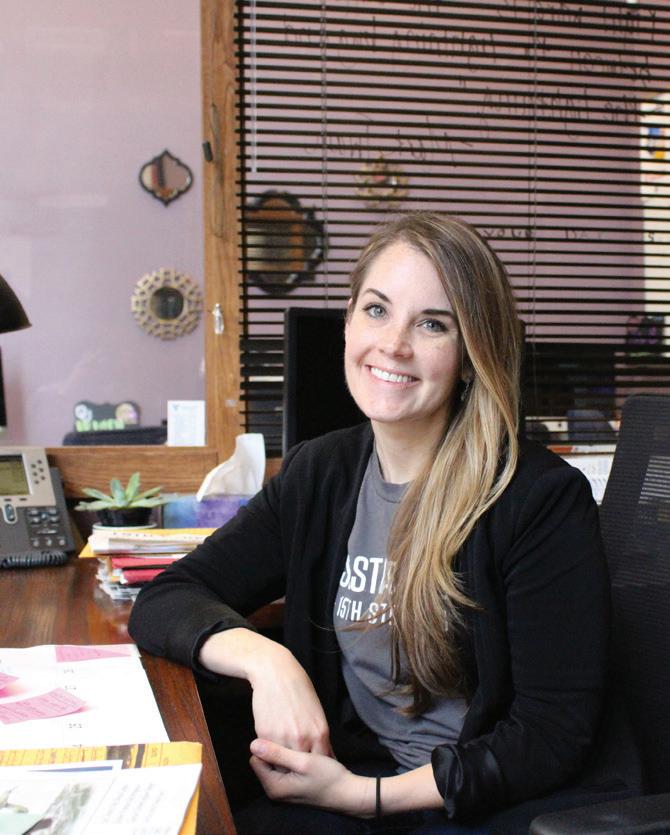
A Rose State journalism graduate, Professor Darcy Delaney-Nelson received a bachelor’s in journalism and mass communication, with a minor in sociology, as well as a master’s degree in JMC from Gaylord College at the University of Oklahoma. She has experience in a number of mediums and served as the public relations specialist and technical writer for a software company prior to her working at Rose.
Darcy Delaney-Nelson Mass Communication Program Head & Student Publications Adviser ddelaney@rose.edu
The 15th Street News and The 6420 welcomes and encourages letters to the editor. Letters should be a maximum of 300 words and are subject to editing for obscenity, clarity and space. Submissions must include name, major and phone number. 15th Street News reserves the right to not publish submitted letters.
Letters to the editor may be hand-delivered to FA110. Policies
The 15th Street News is published monthly and The 6420 is quarterly as designated public forum. Student editors have the authority to make all content decisions without censorship or advance approval. Columns, commentaries and letters to the editor are personal opinions of the writers and do not necessarily reflect the views of our publications or other students, faculty or administrators of the college.
Anyone having a complaint may contact the Editor-in-Chief, 733-7400.
15th Street News is a member of OCMA, OPA and the ACP.
This publication is printed by Mercury Press, issued by RSC and authorized by the Adviser of Student Publications.
RSC is in compliance with Titles VI and VII of the Civil Rights Act of 1964, as amended, Executive Order 11246, as amended, Title IX of the Education Amendments of 1972, Americans with Disabilities Act of 1990 and other federal laws and regulations does not discriminate on the basis of race, color, sex, age, national origin, religion, disability, sexual orientation or status as a veteran in any of its policies, practices or procedures.
This includes, but is not limited to, admissions, employment, financial aid and educational services.
Cover photo by Michelle Rojano

Bailey Walker
Assistant Editor bailey-walker@raider.rose.edu

Gonzalez News Editor yesenia-gonzalez@raider.rose.edu

Hollye Carroll

julie-archer@raider.rose.edu

Kessley Miller Advertising & Social Media Director kessley-miller@raider.rose.edu

Brayden

Yesenia




Real Talk
“What are your plans for winter break?”

Grady Englebretson Fine Arts Major
“I’ll be spending time with family, my girlfriend and doing some community service at an animal shelter or food bank.”

Miguel Lopez Aerospace Engineering Major
“Staying with family. I’m not from here and don’t have any family around, but my cousin is coming down from Kansas. I’m excited to see them.”

Dr. Nyla Ali Khan
English Professor
“I’ll be working on my sixth book, which is about strategies for youth empowerment.”

Dr. Guy Crain
Philosophy Professor
“We always go to Christmas Eve service, then eat an entire roast beef. After that, we’ll be going to a cabin in Broken Bow for our anniversary. Kinda like glamping.”

Jazmin
Minns
English Major
“I’m going to Dallas to see family. We have a tradition of staying up till midnight to open presents.”
What’s in My Bag?
For this issue’s “What’s in my bag?,” we interviewed Paige Stramski, a recruiter at Rose State.
Story & Photos by Yesenia Gonzalez
Paige Stramski is a recruiter at Rose State. She attended Rose State from 2011-2013 and later transferred to Oklahoma State University for a degree in marketing. Stramski was active in Rose State Student Senate during her time as a student and served as secretary during the 2012-2013 school year. Stramski works with student affairs, and her duties include assisting student organizations, the Student Senate, maintaining club budgets and managing event requests. She enjoys organizing campus events and wants to continue working with student organizations. This is a look at the essential items Stramski carries in her purse.
• So definitely this is really random. Everyone always makes fun of me for this but they always wanna use it, so, it works out in my favor. I keep this —I'm notorious for my phone dying, like, all the time, any -
where —and so I keep a travel, like battery thing on me and so, that way I have my phone charger. Normally, I have this massive one. I have a smaller one, but it was dead and so, I have my big one today.
• I always have my makeup [with me]. I always have it with me because I don't always put it on in the mornings, but if I'm going to a college fair, I don't necessarily. Sometimes, I have to wake up really early and so, I don't necessarily want to put it on at like 4:30 in the morning and then drive two hours with it, but I have it with me. That way, when I get there, you know, I don't have it on and I need to go to a meeting or something, I can throw a little bit on because I always have my makeup in here with me.
Other Essentials:
* A brush, that is crucial.
* Sunglasses.
* Hand lotion, for sure. Especially this time of year.
* And a pen. I always have a pen in my purse because I hate [that] you always need one and you never have one, and so I always try to keep one with me.
* This time of year I try to keep a pair of gloves in there just, having to give campus tours, you know, my hands might be getting cold.


Toxic Transactions
Chemicals, pollution provided with purchase
Story by Bailey Walker • Photos by Michelle Rojano
Nearly every time someone sets out to buy an item, they get something extra for free. People often do not get a choice in whether or not they receive a receipt with their transactions, a piece of the 4 million pounds of waste that these transaction records become each day.
According to the Minnesota Pollution Control Agency, more than 90 percent of Americans get no choice in whether Bisphenol A, commonly known as BPA, ends up in their body when handling these bits of paper.
The saturation of receipts is not a common experience around the globe; the U.S. takes a disproportionate amount of the market and is projected to hit 4.5 billion dollars of thermal paper spending by 2028, according to Persistence Market Research.
The negative impact of receipt circulation goes beyond landfill real estate. According to the Clinton Global Initiative, 250 million gallons of oil, 10 million trees and 1 billion gallons of water go into the production of these receipts annually.
Thermal paper receipts are printed by applying heat to a reactive coating containing BPA or BPS (Bisphenol S). Both BPA and BPS are chemicals that have been linked to adverse health effects such as endocrine disruption, cancers and metabolic disorders, though the severity is disputed.
These 4 million pounds of waste do serve some kind of purpose before hitting the landfill. Receipts are used to record business expenses for tax reasons and reimbursements, but when it comes to the average consumer, physical receipts have no practical use.
A hindrance to the viability of physical receipts in the contemporary world is sustainability. Humanity is producing more garbage than ever before.
A World Bank report estimated that 3.5 million tons of trash is churned out daily, which is expected to double by 2025 and projected to continue growing through 2100.
Physical receipts are another member of the pollution dog pile, with absolutely no sign of slowing down. Thermal receipts cannot be recycled in a professional or personal context so the BPA and BPS they contain ends up in the soil, leaking into groundwater and making its way into plants. Receipts cannot be used in compost piles, as BPA and BPS can contaminate fruits and vegetables grown in that soil, causing or exacerbating adverse health effects.
The American Chemical Society Journal of Environmental Science & Technology reported 94 percent of tested receipts contain BPA or BPS, some more than 1,000 times higher than that in BPA-laden plastic food containers and water bottles. The report outlined the environmental impact of receipts, finding 33.5 tons of BPA have spread to the environment in the U.S. and Canada.

“BPA is known to be hazardous to human, fish and other animal reproductive systems and has been linked with obesity and attention disorders,” the Minnesota Pollution Control Agency reported. “The other commonly used chemical for thermal receipts, BPS, has been shown to have some similar effects.”
The average consumer does not need or even want every receipt from their purchases. According to a panel of Underground Cafe employees, most people do not want a printed receipt. Because of this, as well as the environmental factors, the local coffee shop does not print them automatically.
“Yeah, we don’t throw those away, we need those for documentation for sure,” one employee said.
And with most transactions being carried out digitally via a credit or debit card, customers have the option to accept or reject physical receipts.
BPA has been commonly used in all sorts of products and materials since the early 20th century, though a shift is beginning. Some products use “BPA-free” as a selling point and a handful of states have banned the use of BPA altogether. These bans largely target products that may affect an infant’s health, such as bottles and sippy cups, but some states have made the leap to ban it from any food and liquid containers.
In 2006, the largest receipt paper manufacturer, Appleton Papers, claimed to no longer use BPA in their formula. Though small, any steps taken to reduce the prevalence of the un-recyclable plastics is a step toward a safer and cleaner world.

Offense Wins Championships
How football has made a complete 180

Offense (of:fense): The act of attacking. The means or method of attacking or attempting to score.
The age-old adage that defense wins championships is slowly withering away in football. With the introduction of the spread and air raid offense to the game, teams at all levels are making the switch from their slower, more methodical offensive play calling.
Football is always evolving. Players are getting faster, stronger and smarter every day. From the beginning, coaches and players alike have been trying to figure out ways to make the opposite side of the ball look like fools. The triple option (a run scheme that allows the quarterback to give it off to one of his running backs, or keep it himself) is one of the oldest schemes in the book, but still causes havoc on even the best of defenses. Play action, blitzing, screen passes, delayed hand-offs … the list goes on and on. Football, no matter the level of play, is a physical game of chess. Not every move will work, but the ones that do can capture the king.
Defense was the name of the game for nearly 100 years. Glorified by coaches like Buddy Ryan, George Halas, Bill Belichick and Tom Landry, the defense was what won championships. It did not matter how many points their team scored, so long as that they kept their opponent from scoring.
Over the past 20 years, the philosophy has changed. Coaches like Mike Leach, Bill Walsh, Lincoln Riley, Andy Reid and Sean McVay have turned football on its ear. The new approach to football has become score first and score often.
Defenses are no longer on the field to stop the offense from scoring but to cause turnovers and allow the offense to catch their breath. The average amount of points a team scores in an NFL game has had a consistent climb since
2001. Teams have gone from averaging 20.2 points per game to 24.2 points per game. In college football, Oklahoma had the best scoring offense in 2003, averaging 42.9 points per game. That would be sixth best in the 2018 season. Could it be the defenses are becoming worse? Or are the offenses becoming great?
Dave from the BigPlay blog in Cleveland said “Given the role changes focused on protecting the quarterback, I don’t think this trend is going anywhere anytime soon.”
Offenses are finding more space than what is on the 52.5 by 120-yard field. Teams are stretching defenses horizontally and vertically, which makes coverage scarce. Combine that with the strict rules regarding hitting the quarterback, making high hits less legal and the crackdown on hand checking and contact made between wide receivers and cornerbacks, football finds itself putting up video game-like numbers almost every time a game is played.
Sunnye Ropp, a longtime OU season ticket holder said today’s football is “like watching a basketball game ... It’s fun to watch the offenses score, but it’s definitely a culture change in football.”
Offenses have been winning teams championship only recently. Super Bowl 52 had a final score of 41 to 33. The 2017 National Championship between Alabama and Georgia put up 66 total points. Georgia had to put up 52 points and went into two overtimes against Oklahoma just to have a shot for the National Championship.
Offense is here, and it is here to stay. Trends will come and go on both sides of the ball, but offenses will put up points long into the future.
Story by Brayden Conover

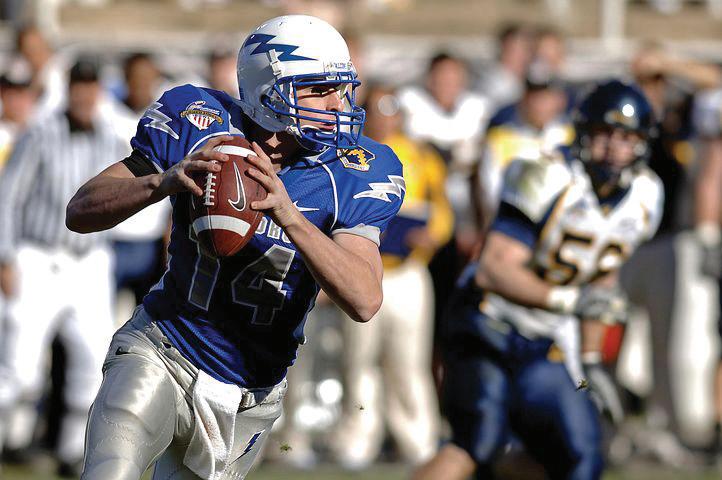





What’s Curls Got to Do With It?
Styling and Maintaining Type 4 Curls
Story by Selena Williams • Photos by Julie Archer
Hair is categorized by hair type. Each type has a different texture. Type 1A is naturally straight hair with absolutely no wave or curl to it. Type 4C is considered the tightest curl.
Although society does not have the ability to tell people what to do with their hair, it promotes a standard of what beauty should look like. The media’s representation of beauty is so narrow and people who are not confident in themselves can fall prey to altering their appearance in order to feel accepted.
According to Taniah Herron, a sociology major at Rose State, hair was considered to be good straight or wavy in her family. Taniah has type 4c curls and her mother, Tamica Webster, has type 3a curls.
“Growing up even to this point, I still have people in my family that believe that good hair is biracial hair or straight hair,” Herron said. “You know, the finer the hair the better the hair or the more defined the curl is, the better it is. Still, to this day, I look at it like that, you know the easier your hair is to tame the better your hair is. So, you know I do like my hair, but at times I look at it like ‘Oh, I wish I had this person’s hair,’ because society tells us that’s what good hair is.”
Soon-to-be aesthetician and Rose State biology major Olivia Tarver thought the same.
“I feel that society tells us that natural hair should be straight and you shouldn’t embrace your curls,” Tarver said. “It took a while to start loving my naturally curly hair, but I think being natural made me look at myself like I'm worth more, it made me realize that I don’t need to be what society considers unique.”
According to Herron, people prefer straight hair because it is considered to be more clean and classy.
“I remember people coming up to me when I first really started wearing an afro, they would say, ‘oh, my gosh!’ I really love the wild hair,’” Herron said. “I don’t really know what that means; maybe they’re saying that curly hair is considered to be out of the ordinary and that’s what makes them feel so uncomfortable because nobody’s
curl pattern is the same. No matter if you have 4a or 4c, we all have different curl patterns. Our hair flows a certain way whereas, with straight hair, you either have thick or thin.”
Types 4a and 4c curl types do not have a defined curl pattern. It shrinks 70 percent more than any other hair texture.
How to moisturize type 3 or higher natural curly hair
Deep conditioning, oil treatments and hair masks are the best for keeping curly hair moisturized and fresh.
“I think a person with naturally curly hair should deep condition twice a week,” Tarver said. “Also, what keeps your hair healthy are scalp massages, they will promote hair growth and blood circulation.”
She also emphasized the need for leave-in conditioner.
“Wet Line Xtreme Professional Styling Gel is a great gel to use on curly hair because it won’t make your hair feel crunchy. Some other products to use are Nairobi, Shea Moisture, TGIN (Thank God It’s Natural), Carol’s Daughter and Camille Rose Naturals Products.”
How to maintain naturally curly hair
“Protective hairstyles like braids and twists are a perfect way to maintain curly hair and to promote hair growth,” Tarver said. “Also, stay away from any products that contain alcohol, sulfates and parabens; use satin hair ties when you put your hair up in a bun or ponytail to avoid breakage.” It is also important to avoid over processing hair.
“If a person with curly hair wants to switch up their hairstyle, I recommend them straightening their hair only once or twice a year,” Tarver said.
In spite of societal standards often determining what is considered beautiful, curly hair is natural and learning to care for it can help women better appreciate themselves.
For a hair texture quiz, visit the6420.com


Furniture Revamp
Story & Photos by Yesenia Gonzalez
Remodeling furniture is a great way to give new life to old furniture. It is also perfect to for anyone looking for a unique piece to update someone wanting to take up a new hobby. Customized furniture can be painted to match any color scheme or room decor.
Materials:
- Screwdriver
- Wood Putty
- 100-grit Sandpaper
- 4-6 tack cloths
- Painter's Tape
- Paint Brushes or Rollers
- Paint Tray
- Water bucket to clean brushes
- Paint suitable for wood
- Paint Primer
- Paint Sealer
- Stencils (Optional)
Instructions:
• Step One: Remove any knobs, pulls or metal pieces from the furniture.
• Step Two: Apply wood putty to any cracks and allow to dry before sanding. Sand down all areas of the dresser that will be painted. Use 100-grit sandpaper for this step and sand in the direction of the wood grain for a smooth surface. Some paint brands do not require sanding before painting. Read manufacturer directions before beginning a project. Latex-based paints require a primer and polyacrylic sealer suitable for wood to produce the best results, although an oil-based primer can also be used. Oil-based paints require an oil based primer and a polyurethane sealer.
• Step Three: Wipe down sanded surfaces with a tack cloth to remove fine dust particles.
• Step Four: Use a paint brush or roller to apply an even coat of primer. Allow an hour or however long the primer manufacturer recommends for drying. Always apply primer, paint and sealer in a well-ventilated area.
• Step Five: Apply a thin coat of desired paint to the furniture. Allow at least an hour or the paint manufacturer’s recommended time to dry.
• Step Six: Apply another coat of the desired paint and allow to dry accordingly.
• Step Seven (Optional): Use a stencil or paint a design freehand with desired colors. Painter's tape creates defined edges on geometric designs.
• Step Eight: Apply paint sealer to furniture with a paint brush or roller. Some light colored, oil-based paints can yellow over time, especially if used without a sealer. Allow paint sealer to dry according to the manufacturer's directions.
• Step Nine: Reattach any knobs, pulls or metal pieces to the furniture. Looks Great!

B E F O R E A F T E R
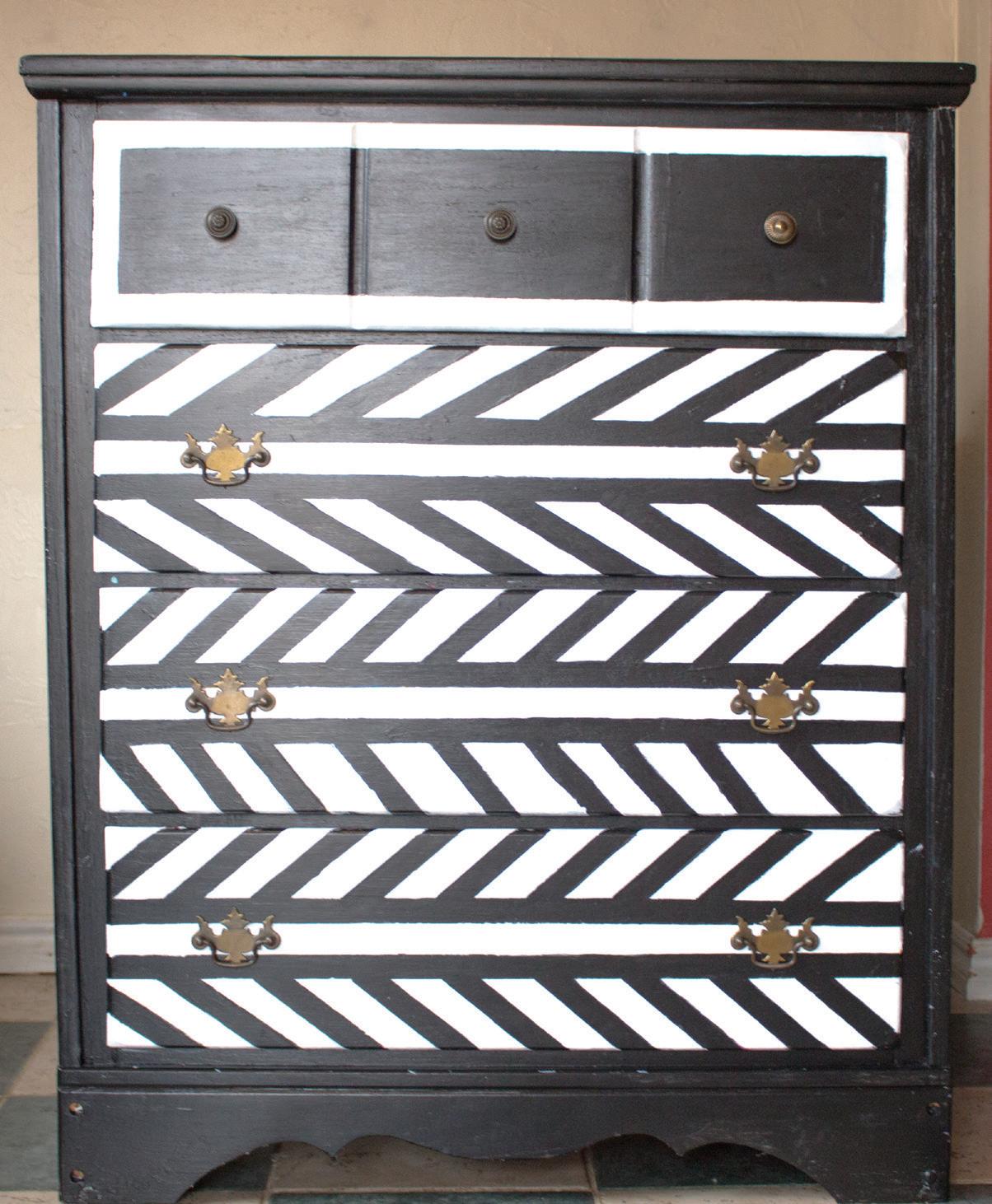





Social Media’s Social Impact
Story by Michelle Rojano
Social media has become a daily hobby in many people’s lives. About 77 percent of the U.S. population was active on social media in 2018, according to Statista, and around 92 percent of teens access the internet daily. Although social media can be a useful tool for many, there is a risk of exposing young children and teens to content and attention for which they may not be mentally prepared.
Popularity
Similar to school experiences, kids and teens strive to fit in and be liked on social media. Except now, there is a measurable amount of “likes” and attention.
“For younger people, likes are really important to the popular people because they have to have a certain number of likes or they aren’t good enough,” Tapangia Richardson, a high school senior said.
Forty-three percent of teens ages 13-17 delete posts because they have not received enough likes and even feel negatively about themselves when no one likes or comments on the posts, according to Common Sense Media. Copying trends for likes and shares
People of all ages can quickly immerse themselves in viral trends. The Harlem Shake, Ice Bucket Challenge, Baby Shark, Kiki Challenge, Duck-face Photo, Tide Pod challenge, California Reaper Challenge and the Cinnamon Challenge are just a few examples of viral videos that influenced many. Some of these trends can be positive, like giving food and money to charitable causes, but the majority are strictly for entertainment.
“Social media is not healthy for young adults because one person does something stupid, like eating a Tide pod, and it’s now the thing to do and is the latest challenge,” Richardson said.
Influenced content does not strictly stop at video challenges; it also includes fashion, makeup, photos and body trends. According to Shareablee, seven out of the Top 10 social media influencers are female celebrities, including Kylie Jenner as No. 1, Kim Kardashian as No. 5 and Nicki Minaj as No. 8.
According to Dr. Elizabeth Boger, professor of psychol -
ogy, research has proven consumers are in fact impacted by media. She also mentioned how younger audiences are more vulnerable to fads, diets and fasts endorsed by celebrities.
“Adolescence is a period where a person's appearance becomes more important to them-for a variety of reasons,” Boger said. “Given the increased importance of a person's perceived appearance and the ease of access to celebrity images, it's pretty easy to see why celebrities can have such an impact,” Boger said.
Social media influencer’s lips and bodies have been the cause of many girl’s photos, poses and purchases. From posting selfies almost identical to the influencer’s to overlining lips, it is obvious these celebrities have led and contributed to photo, makeup and body trends.
“Celebrities do have an impact on young followers … a lot of celebrities are really skinny and almost so skinny it’s not healthy and they are considered beautiful,” Richardson said. “Also, celebrities help inspire young kids to become the next celebrity or just like the celebrity,” Richardson said.
Body Image
Body image refers to how people view themselves. Body Dysmorphic Disorder is when someone has a consistent issue with an imagined or minor flaw, according to Mental Health America.
“Research varies on the percentage of the population with BDD, due to the potential for underreporting,” Boger said. “It is a disorder where people seek to be less noticeable, as opposed to more noticeable, and how marked the disorder is changes over time and may be more or less intrusive at different points in a person’s life. The most recent statistics I've seen indicate around 2.4 percent of the population has it, but again there may be many more people who don't realize that's what they're suffering.”
Constantly comparing one’s body to others is a symptom of the disorder. Social media is an easy way for ordinary people to compare themselves to celebrities and people in their own lives. This explains the trend of portraying the body and look of popular people on social media.
Most women will use makeup to look better and hide
flaws. Recently, the feature of plump lips and perfectly shaped eyebrows has taken over the internet. Women have quickly fallen into the trend by showing off their makeup looks of dark, similarly shaped eyebrows and by watching tutorials on how to overline lips to appear larger thousands of times.
Illusion of Social Media
Not only can social media be taxing for users comparing themselves to Instagram models, but it can also be exhausting for influencers. Many YouTubers and Instagram models have fallen off the map or begun to change their content to real life content. Evenlina, a YouTuber and influencer, has recently shared a video describing her experience in keeping up the lifestyle she portrayed in social media and how the industry is full of people living double lives for likes and views.
“I spent a couple of hours getting ready, doing my makeup, doing my hair, setting up the lighting and everything, and I look in the camera and it doesn’t look right... In my heart, I know that I am not ugly or a super insecure person but for [making content] I get so much anxiety, so much stress over how I look on camera as I am filming and I am doing it right now, I am already running all of the negative comments.”
Social media can make vulnerable people an easy target for bullying. It is widely known that young users have gone as far as taking their lives due to online bullying. Even adult users fall prey to wide scale ridicule; characters like Sweet
Brown, Walmart yodeling boy and many others have turned into internet jokes. Although the attention can turn positive in many cases, for others, it can push them to extreme actions.
Body Disorders
Social media is not the sole cause for bulimia, depression or anorexia, but it can trigger those who are vulnerable.
“Of American elementary school girls who read magazines, 69 percent say that the pictures influence their concept of the ideal body shape, 47 percent say the pictures make them want to lose weight,” according to National Eating Disorders Association.
Americans have now replaced written media with online websites and social media, meaning young people have the same content at higher volumes and readily available. Although less prominent, National Eating Disorders Association also linked photos and media to men’s body image.
According to Boger, it is easy for people to confuse a person’s looks with their expertise about a subject. If someone loses weight easily and is considered beautiful, it is easy for people to consider them experts on the subjects of beauty and health. People will be more likely to trust their advice.
“A celebrity who lost a lot of weight after an illness, pregnancy, or other situation may mention their favorite fast/ cleanse/diet… but they may not mention the personal trainer, the many hours each day spent working out, the expensive food prepared by someone else and many other factors
that allow them to lose weight quickly,” Boger said.
Body Positivity
Despite the risks, social media has begun to make a push into body positivity and natural beauty. Victoria Edmond, owner of Burden Free Cosmetics, focuses her brand on not only making people look beautiful, but also feel beautiful.
“[Our goals] are to encourage women to radiate their unique beauty from the inside out.”
As a young woman herself, she is no stranger to the challenges social media poses to self-love.
“When we try to be like each other we are missing that gold mine of diversity,” Edmond said.
Worldwide brands have also begun to support body positivity and diverse beauty. Aerie has recently launched a campaign featuring models of all weight, sizes and disabilities. Dove has also joined the movement, featuring women and children of all sizes and backgrounds into their advertisements.
From true nude lip shades for darker complexions to foundations that match a wider range of dark skin tones, Fenty by Rihanna has added to the otherwise limited range of makeup for women of darker skin tones. Nike has even began selling its first ever sports hijab. The support of brands in diversity campaigns helps people embrace individuality.
Healthy Use of Social Media
It is important for adults to take steps to monitor children’s and teen’s social media use. Parents should have an idea of their children’s online activity without reading absolutely everything that is posted or read by their children. Boger recommends avoiding intrusive behavior since it could lead to hostility. She also recommended limiting social media use. The average teen uses social media eight hours a day. Limiting the use could help teach them time management skills.
It is also important to lead by example.
“Children, including teens, are acutely aware of their parents’ behavior, including hypocrisy,” Boger said.
She explained parents who use social media in a positive way are likely to have better results in how their kids use social media vs. parents who are on social media eight hours a day and use their social media in a negative way.
Social media has proven to have the power to kick-start change. Activist movements like Black Lives Matter movement, Me Too movement and many fundraisers began online. Besides political movements, people have been able to find true love, support groups, keep up with news or learn about cultures from around the world through social media. Thanks to the massive reach of social media, the world has had a chance to change for the better.
Top Influencers’ Photo vs. Photo Trends on Instagram


Photos on the left are of top social media influencers. Photos on the right are photos found under trending hashtags on Instagram that largely resembled those of top influencers. Thousands of photos can be found that mimic that of celebrities. Although not all photos may be directly traced back to a celebrity photo, there is a clear trend marking it’s way through social media.
Viral trends can start from anyone, however trends that are endorsed or copied by a celebrity can reach a larger audience.
The more people see it, the higher the possibilities of replicas.







Warning: Icy Roads Ahead
Winter is almost here. Temperatures have already dropped below freezing this season. According to winterroads.org, thousands of people die each year from winter-related car accidents and more than 100,000 are injured each year.
Below are a few tips to keep drivers safe on snowy or icy roads this winter.
• Keep an ice scraper and de-icer in your vehicle.
• Do not pour hot water on an iced windshield; this could shatter your windshield.
• Spray de-icer on your car door handles if they’re frozen in place. Pulling on them when frozen can shatter plastic handles.
• Drive slow. Driving fast on icy roads can make you lose control of your car.
• Keep a cell phone with you and make sure it is fully charged in case of emergencies.
• People driving long distances to visit family should be aware of the weather conditions ahead of time and inform family and friends who are expecting them of their planned route and arrival window.
• Do not use cruise control when driving in slippery
conditions.
• Avoid driving under difficult conditions when possible.
• Do not follow other cars too closely. Give yourself enough space to brake.
• Keep at least one blanket and phone charger in your vehicle.
• Bridges freeze faster than any other parts of the road.
Slow down when approaching a bridge.

Fresas Con Crema Strawberries with Cream

Recipe by Michelle Rojano
Ingredients:
• Fresh strawberries or any other berries of choice
• 1 lb of Mexican sour cream, other types of sour cream may be used, but taste may vary
• 14 oz can sweetened condensed milk
Directions:
1. Wash the strawberries.
2. Optional: Cut off the stems of the strawberries and slice them. The size of the slices can vary by preference. Whole strawberries can also be used.
3. Pour all the sour cream into a large bowl.
4. Pour about half the can of sweetened condensed milk into the large bowl with the sour cream.
5. Whisk together until thoroughly combined. Taste the cream mixture.
6. Add more sweetened condensed milk to taste, if necessary. I, personally, use about two-thirds of the can, but if a sweeter cream is desired, more can be used.
7. Place the strawberries in a cup or bowl and pour desired amount of cream. Enjoy.
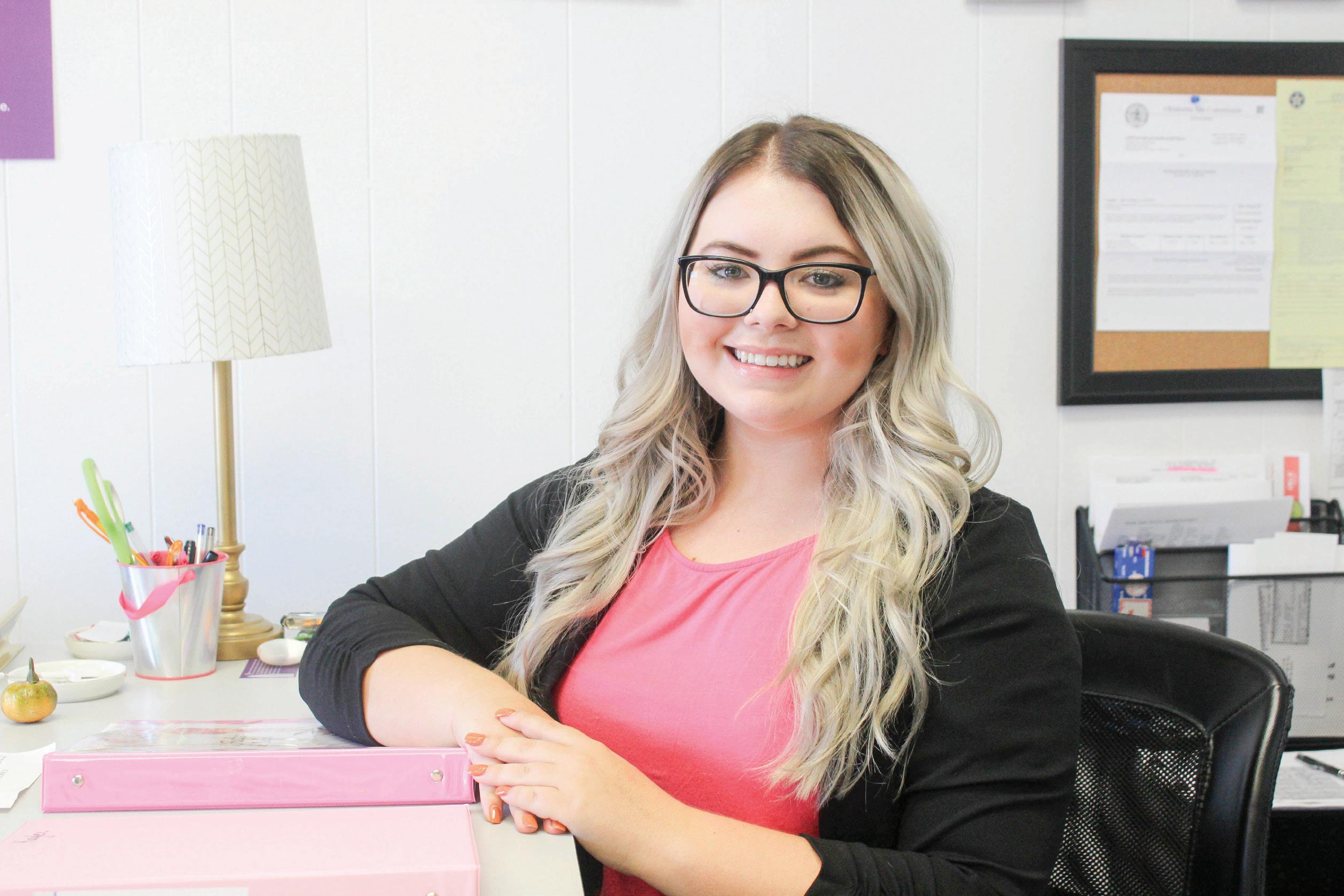
Self-Made Entrepreneur
A Rose State Student’s Business Building Journey
Story & Photos by Kessley Miller
The meaning of success varies from person to person. All people have a goal to fulfill in their lifetime, especially those who run their own business. The mindset of a business owner can make or break how fortunate they will be in their company’s endeavors.
Morgan Hatfield is a 20-year-old businesswoman who has created a base of devoted clients and customers who go to Eyelash Salon located in Midwest City. This salon offers a variety of services, including eyelash extensions, lash lifts and tints, even
eyebrow waxing and eyebrow tints. Clients come from all over the state to get pampered and feel beautiful.
Her passion for wanting to operate her own business started when she was a young girl. Her father is a business owner in Tulsa, which inspired her entrepreneurial mentality.
She saw how her mother worked a typical Monday through Friday job, so watching the different dynamics between her parents helped Hatfield decide what she wanted to pursue as her career. As time passed, she knew that she wanted to be her own
boss.
In 2016, Hatfield was a recent high school graduate and continuing her education at Rose State College. She was also attending the Mid-Del Technology Center to obtain her cosmetology license.
After receiving her license, Morgan then, on a whim, went to Broken Arrow to take an eyelash training class. She explained that if she had never taken that step, she would not be where she is today.
She then started doing eyelashes for people by renting a small room in a massage studio in Midwest City until she could open her own salon. Over the course of two years she worked tirelessly. As a result she was able to save enough money to get her own space.
“One thing I was really big on was marketing,” Hatfield continued. “I started having girls I graduated with come to me [for their lash extensions], then their moms started coming to me and social media has been a huge influence on getting my name out there for new clients.”
cessful business owner, and if an owner does not try to remain innovative with their ideas, their company will become stagnant.
“One thing I would say that has helped me in my career is going to Rose State,” said Hatfield. “When I first started out, I was just a general Business major until I spoke with my Business adviser,” Hatfield said. “He then connected me with the small business operations program which has been very beneficial in the sense that these classes are helping me make the best decisions for my own small business.”
Understanding the risk of owning and operating one’s business is not always going to be obvious. Hatfield added that she believes most people do not realize the amount of work that goes into opening a business.
“One thing I would say that has helped me in my career is going to Rose State.”
- Morgan Hatfield
“Honestly, you have to have a lot of money with owning a business,” Hatfield said. “There are first-time purchases that a person has to make when opening their business, and now that I employ three other women, we spend so much more on inventory than when it was just me.”
Hatfield used marketing to her advantage by frequently posting on her personal Facebook, making business cards as soon as she started doing lashes and putting her business cards in the Midwest City restaurant, Pelican’s.
Taking risks and opportunities are vital keys to becoming a suc-
Because she is young and a woman, many people have doubted Morgan’s capabilities as a business owner. She advised other young women of her personal experience: Many people will try to not take a young woman seriously for their dreams, but women must push through what the skeptics say and remember one important factor – there will be a light at the end of the tunnel.



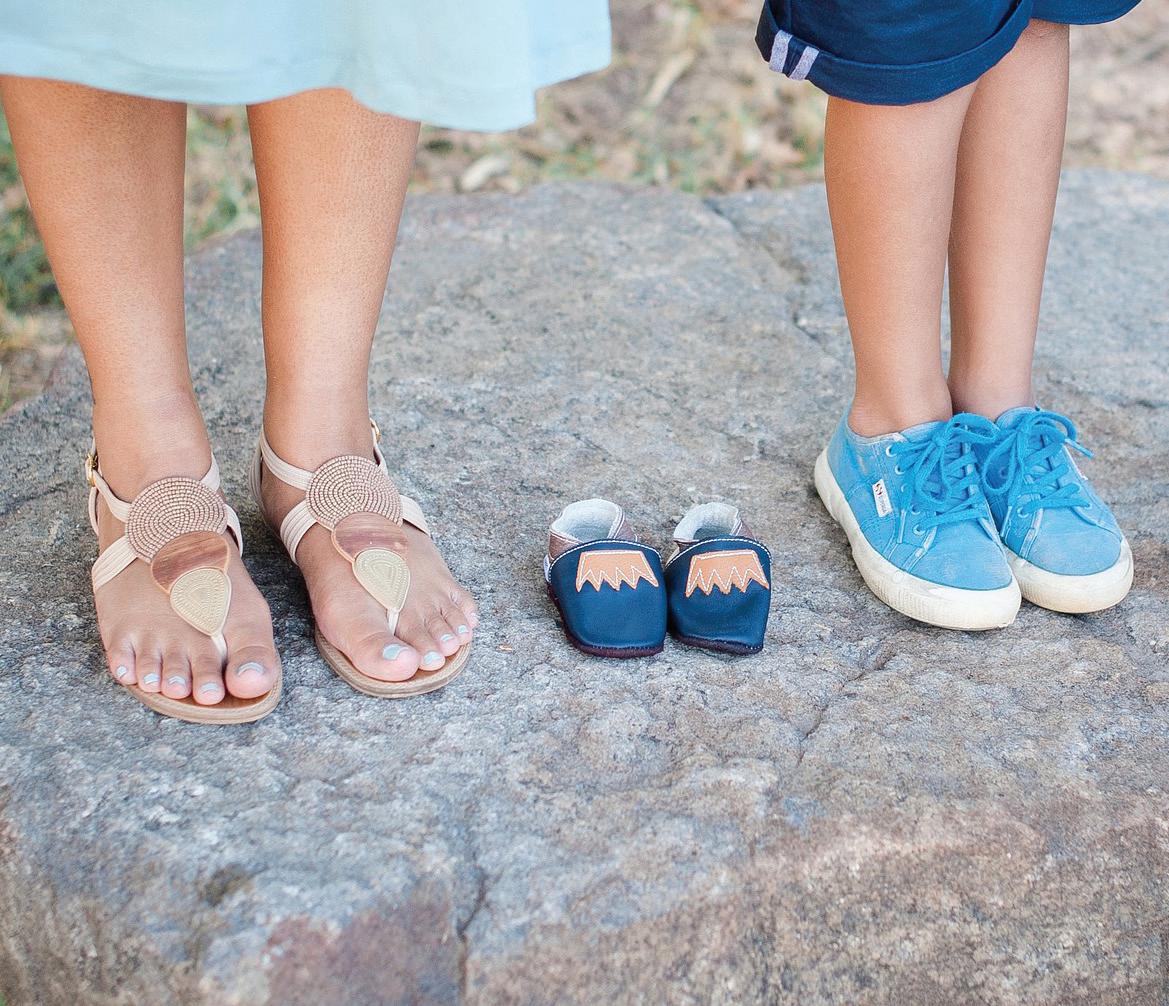

Making a Family:
Journeying through adoption and surrogacy
Story by Madi Zick • Photos by Madi Zick & Stock Photos
According to childrensrights.org, there are currently about 400,000 children in foster care who are waiting to be adopted and the number grows daily.
In the U.S., there are different ways to adopt a child, such as from a foster care system, through a private adoption or as a relative or stepparent. With these options, it appears that adoption is a simple process anyone can do.
Rose State College President Dr. Jeanie Webb explained the process of adoption.
Webb adopted her daughter Anna Grace in June 2002 when she was 14 months old. Webb and her husband adopted their daughter through the agency Small Miracles International and the process took about 10 months. Webb had children before she decided to adopt and encourages others to adopt.
“It is the most amazing experience for both the parents and the child,” she said. “It truly gives a child an opportunity [who otherwise] might have no hope for a family or stable economic outlook. There is nothing more important than changing the life of a child and making a difference in our world.”
She said that adopting was the best and most important thing she has ever done.
want to be a mother,” De Valdenebro said. “[I have] that feeling about being a mother to my daughter and I also have it about being a surrogate. It just feels right and makes sense.”
De Valdenebro is currently on her second surrogacy. She is working with the same couple she carried a child for almost two years ago. At the agency she is working with, a surrogate is required to have at least one child they are raising. While she is unsure of how many times she can be a surrogate, there are different rules for different agencies.
In some countries, surrogacy is illegal and, in others, a surrogate can only receive money for necessary payments, such as doctor’s visits. In America, the payment for surrogates depends on how many children are being carried and what agency is organizing the surrogacy.
“There is nothing more important than changing the life of a child and making a difference in our world.”
-Dr. Webb
For those who do not want to adopt, there are other ways to have children without carrying one. Surrogates have been used since the 1970’s to help parents who want to have biological children. Surrogates are people who carry the baby for the “intended parents” with the parents’ egg and sperm.
In one of the first documented cases of a successful surrogate delivery, the carrier was emotionally attached to the baby and became an advocate against surrogacy thereafter.
Sarah De Valdenebro is a second-time surrogate who works for an agency called Conceive Abilities. She chose this agency because she thought it was important to work with an agency that would keep her emotionally and legally protected.
A question that comes up is how do people become involved in becoming a surrogate? For De Valdenebro, she always wanted to be a surrogate.
“There are some women who just have a feeling that they
A concern that many people have is what happens if the surrogate becomes attached to the baby they are carrying. De Valdenebro is a gestational carrier as opposed to a traditional one, which means that she is not genetically related to the baby. A traditional surrogate is when the carrier’s own eggs are used. De Valdenebro did not see it as “giving away” the baby, but more as giving the baby back to their family.
When it comes to getting selected by a family, De Valdenebro said that the agency spent a lot of time getting to know her and the intended parents. Then they suggest a match with the intended parents. Both parties have to agree to work with each other over an online video meeting, which keeps both of them protected and adds to the level of comfort.
De Valdenebro said that she would never rethink being a surrogate because it has been one of the best experiences of her life and she is thankful to have been able to help a family grow. De Valdenebro wishes people would understand the motivations behind and the relationships involved in surrogacy. She wants to make sure people know that it is not just, “women who want to make money or steal babies.”
To find out more information on how to adopt or how to become a surrogate, check out the agencies listed above.






Brad Edwards’ Warmth 4 Winter





The 15th Street News and The 6420 are collaborating with OKLAHOMA’S NEWS 4 and The Salvation Army for the annual coat drive. Donate new or gently used coats. Donation boxes will be located outside Fine Arts, Room 110 or in the Susan Loveless Center.




The Ugly Truth Behind Beauty
According to PETA, each year, more than 100 million animals in the U.S. are killed because of animal testing. Humane Society International states up to 200,000 of these animals come from cosmetic testing alone. Cosmetic testing does not mean that scientists are applying blush on bunnies.
Skin and eye irritation tests are performed where chemicals are rubbed on skin or dripped into eyes. Bunnies, mice, guinea pigs and dogs are force-fed and held under observations for months at a time to see an illness an ingredient may cause. Lethal dose tests are also performed, where animals are force-fed chemicals until they die so scientists can determine the lethal dose. Animals are left with burns, bleeding skin and organ damage. At the end of testing,
any remaining animals are killed through lethal injection, neck-breaking or decapitation.
Some alternatives to animal testing are in vitro test methods, meaning testing on human cells or tissues, human patient simulators and non-invasive imaging techniques such as MRI and CT scans.
“In the U.S., there is no single legal definition of the term ‘cruelty-free,’ and the FDA’s website even states that this allows for the unrestricted use of the term,” Amanda Nordstrom, company liaison for PETA’s Beauty Without Bunnies Program, said. “Unfortunately, this means that some companies may state that they don’t test on animals – even while they’re paying for tests on animals in China.”
Story by Julie Archer • Photos by Julie Archer & Stock Photos
When looking for companies that are legitimately cruelty-free, it is important to research if they sell products in China because Chinese law requires all cosmetics to be tested on animals. There are companies that will say they are cruelty-free because they do not test their products on animals in other countries, but continue to sell their products in China, which are tested on animals.
“NYX, a brand of L’Oreal, does not test any of its products or ingredients on animals and has been at the forefront of alternative methods for over 30 years,” said a NYX cosmetics representative.
Although L’Oreal is not a cruelty-free company because their products are sold in China, once NYX was acquired by L’Oreal, NYX Cosmetics kept their commitment to being a cruelty-free company. They do not sell their products in China and their products are now vegan-friendly as well, meaning there are no animal products used in their cosmetics.
A popular animal product used in eyeshadows is carmine, a red powdery substance that is made by crushing dried insects. It is used to create variations of red, pink and purple pigments in cosmetics. Companies who are vegan use pressed-pigments instead of carmine in their eyeshadows. Pressed-pigments are a loose powder and the main ingre -
dient in eyeshadow. In normal shadows, the pigment is put into the pan with other ingredients (like talc) to make the eyeshadow smooth. For red eyeshadow, mixing the pigment with the other ingredients dilutes the color, thus making a pressed-pigment, the loose powder pressed into a pan.
As more technology and safer ingredients become available, companies are making the switch to being cruelty-free. CoverGirl, a company who has sold in China for years, pulled their products from China and are now certified as cruelty-free.
“[Cosmetic testing on animals] is not required in the U.S., and these tests are now illegal in all member countries of the EU, India, Israel, Norway, Turkey, New Zealand, Switzerland, and other regions,” Nordstrom said.
One of the best ways to combat animal testing is to only purchase products that are cruelty-free, which creates a demand in the market for cruelty-free cosmetics and provides a monetary incentive for cosmetic companies to sell cruelty-free products. An easy way to tell if the brand is 100 percent cruelty-free and not selling their products in China is to check the back of the box on the product. At the bottom, there should be a small bunny that says cruelty-free.
To find a list of all brands that do not test on animals, visit features.peta.org.


Yes, Looks Matter
Insight into why we value physical attraction
Story by Carmen Jacobs • Photos by Carmen Jacobs & Stock Photos
“It’s not what’s on the outside, it’s what’s on the inside that counts,” this and other similar sayings are frequently quoted when it comes to the subject of attraction.
The media perpetuates the narrative that physical appearance should not be a factor in the pursuit of romantic relationships.
Simultaneously, the media contradicts this and maintains a fixation on superficial, aesthetic qualities and continually inundates the public with templates of what an attractive person should look like. The entertainment, fashion, makeup, social media and dating app industries are some of the biggest culprits.
For example, Tinder is a popular dating app structured in a way that forces its users—all 50 million of them—to choose potential partners based almost purely on their looks. This allows users to find dates quickly and maximize
their chances of finding a desirable partner. The media’s impact on the degree to which people value aesthetic is undeniably powerful. However, as powerful as it may be, is it the only factor influencing human attraction? Are there internal, individualistic factors that influence to whom one is attracted?
“I think all women are pretty.” Jacob Dawson, a liberal studies major at Langston University, said. “I’m not really a judgmental person, so I don’t really care about looks.”
In every corner of the world, there is diversity in the attractiveness of people in relationships. If people had to fit society’s image of beauty to date, only a minuscule amount of people would be in relationships.
Humans are born with a psychological mechanism that causes individuals to almost exclusively seek relationships with people in their own perceived realm of physical attrac -
tiveness.
It does not just apply to people turning a blind eye to those deemed less attractive than them. The principle also applies to people deemed more attractive than them.
Of course, there are many couples who exhibit drastically varying levels of attractiveness who appear to be exceptions to this rule. Non-physical features such as money, power, status and fetishization can, and often do, impact relationship pairings. Still, these relationships cannot be fully regarded as “exceptions” to the scientific rule.
According to Rose State Psychology Professor Dr. Richard Wedemeyer, people make the conscious decision to date someone for superficial reasons.
“This behavior is actually immoral, perhaps this is what people are thinking of when they think shallow,” Wedmeyer said.
As it seems, the stereotypical belief that people in unequal relationships are likely dating their partner for superficial benefits is relatively true.
“This is why when we see an unlikely couple— an odd pairing walking down the street— we feel a bit of initial shock,” Wedemeyer said. “We are a bit surprised. We feel this way for a reason—it’s not ‘normal’.”
Considering that shallow relationships are driven by ulterior motives, it is logical to conclude these couples do not
actually defy the psychological principle. These relationships are created with shallow, insincere intentions and sacrifice the core values of a true, healthy relationship.
Even accounting for the impactful psychological factors, it is not surprising that someone in a high position of power would pursue a relationship with someone perceived to be far more attractive than them.
The media gives society the impression that being in a relationship with someone seen as extremely physically attractive is a coveted accomplishment. This is one way the outer influence of the media still finds a way to override human nature and psychological instinct.
All things considered, this situation also does not break the scientific rule: the described person above would not be seeking a true connection to begin a sincere relationship. Instead, their desires and impulses would be almost completely superficial.
These examples and many others reflect how powerful the media’s influence can be on relationship formation and physical attraction.
Yes, looks do matter—and not only because the media tells society they do. While the media’s outside influence does play significant role in relationships and attraction, the inner workings of the brain are what actually determine to whom individuals view as an ideal match.


Winter Event Calendar
Oklahoma City
Thunder vs. Chicago Bulls
Chesapeake Energy Arena
7 p.m.
Territorial Christmas Celebration
212 W Oklahoma Nov. 24- Dec. 24

Christmas Day
Ugly Sweater Day 5K & 10K
Oklahoma City, OK 73125 1 p.m. Dec. 19 & 31


American Farmer Exhibit Chisholm Trail Heritage Center Ends Jan. 7

OKC Thunder vs. Minnesota Phantom of the Opera Civic Center Music Hall Closed Mondays Jan 9-20
The Space Lab Comedy & Improv Tower Theatre 7-8 p.m.
First day of Kwanzaa Saint’s Sessions Saint’s Pub OKC Thursdays Dec.
NYE Black Tie Masquerade Enigma Grille & Lounge Chickasha Festival of Light Ends Dec. 31 Thurs
Tulsa Shoot Out 4145 E 21st St 8 a.m. Jan. 1-5 Big Om Yoga Sequoyah Park


Happy 2019


Happy Holidays

A Drag Queen Christmas Rose State College
Christmas Express Oklahoma Railway Museum Dec. 8-22 Lab Sketch
Hudiburg Chevrolet Center
8 p.m.
Dec. 6 - Dec. 27


Holiday Pop-Up Shops Bleu Garden Nov. 23- Dec. 23
OKC Blue vs. Windy City Bulls Cox Convention Center
7 p.m.
Eagle Watch Salt Plains National Wildlife Refuge
4 p.m. Jan. 4-5
Holiday Water Taxi Rides
Bricktown Canal Nov. 23 - Dec. 30 Thursdays - Sundays
Victorian Radicals Exhibit
Oklahoma City Museum of Art
Ends Jan. 6, 2019
The Oklahoma Wedding Show
PBA Oklahoma Open and Roth/Holman PBA
Doubles Championship FireLake Bowling Center
10 a.m. - 3 p.m.
Crossword Puzzle


Holiday TRIVIA


Rudolph the RedNosed Reindeer was created as a promotion for what store?
a.) Montgomery Ward
b.) J.C. Penny
c.) Macy’s
d.) Nordstrom

In “The 12 Days of Christmas” there are how many drummers drumming?
a.) 10 b.) 8 c.) 12 d.) 6
In which ocean is Christmas Island located?

a.) Atlantic b.) Arctic
c.) Southern d.) Indian

Eggnog was first consumed in which city?
a.) Jamestown, VA
b.) Provincetown, MA
c.) Boston, MA
d.) New York, NY

What is the scientific name for a pine tree?

What did Harry Potter receive for his first Christmas at Hogwarts?
a.) Quidditch Broomstick
b.) Invisibility Cloak
c.) Time Turner
d.) Marauder’s Map
a.) Pinol
b.) Linus van Pelt
c.) Pinafore
d.) Pinus

